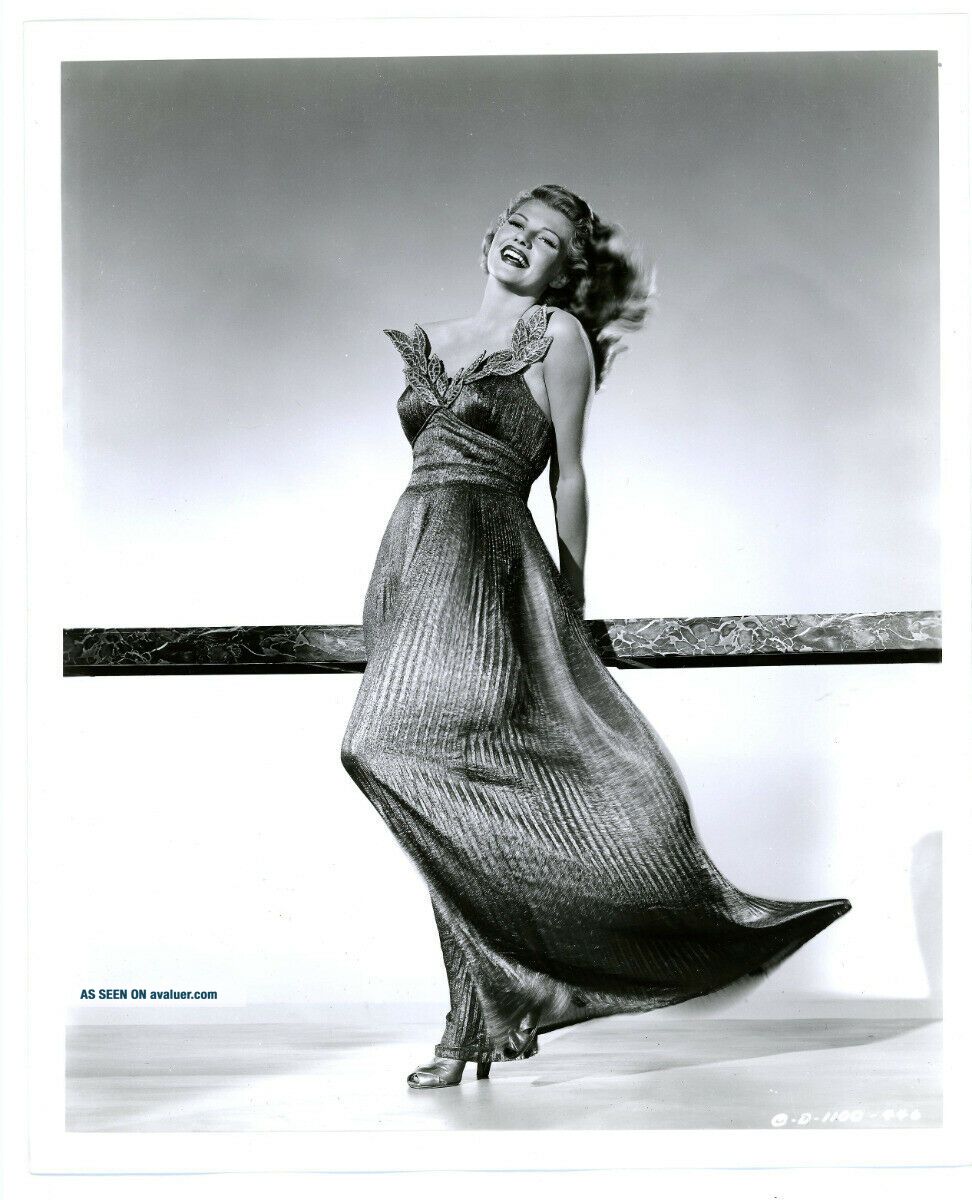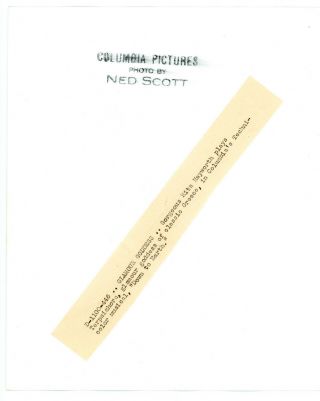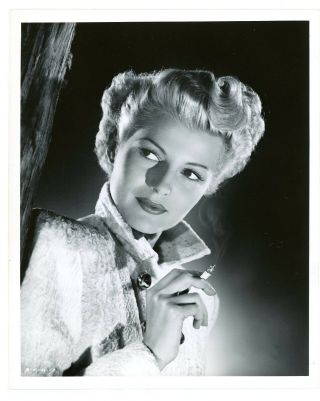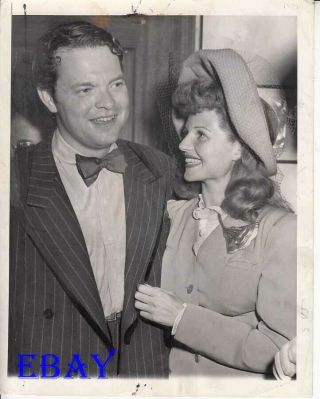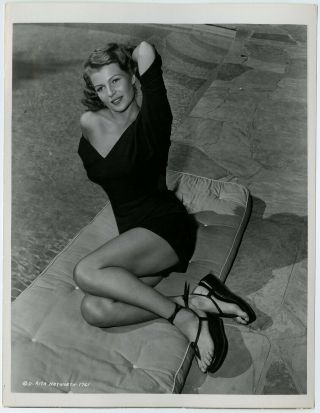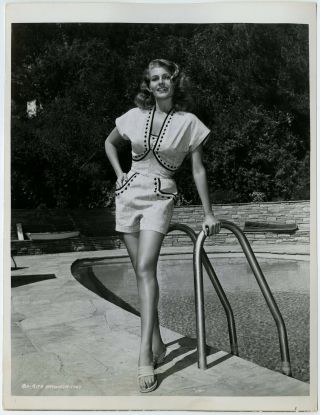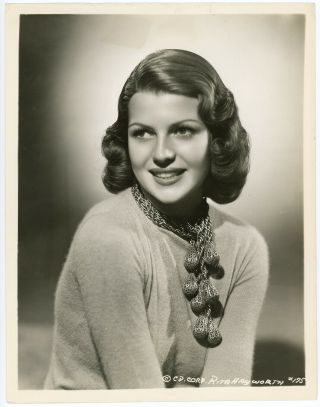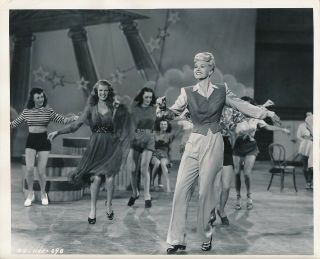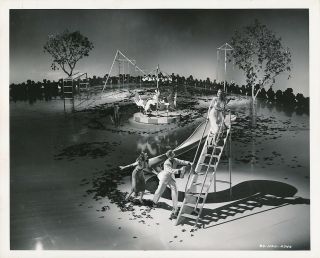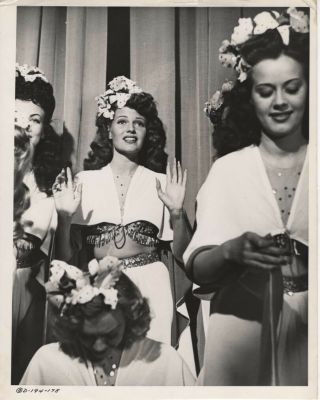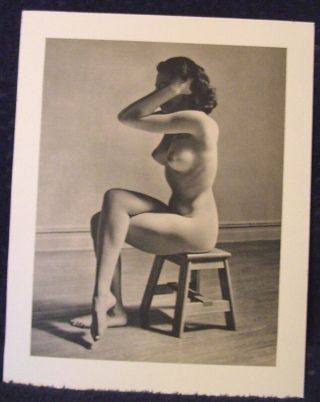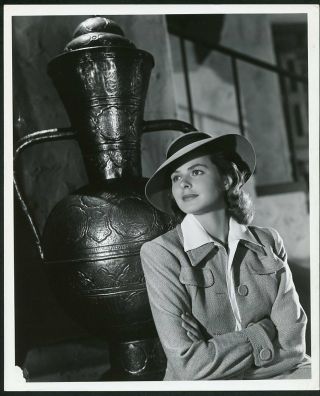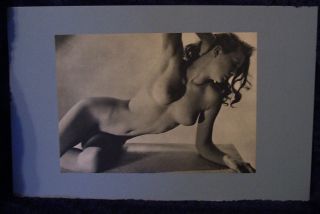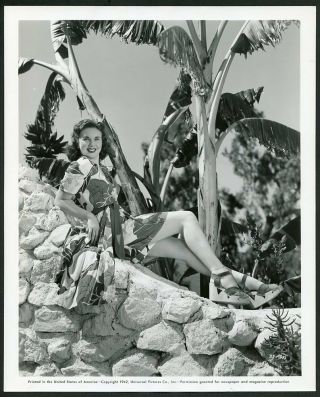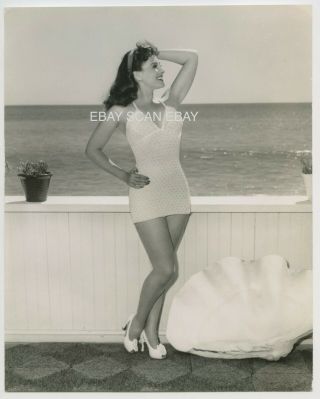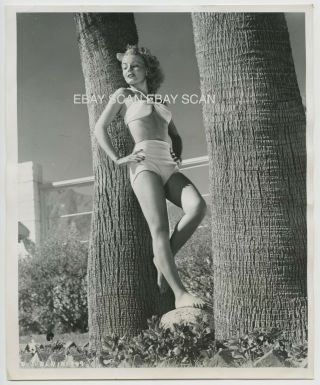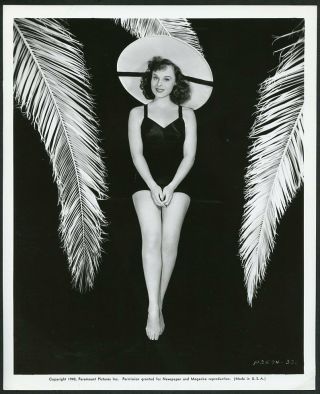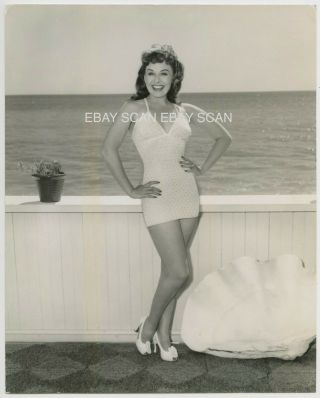RITA HAYWORTH VINTAGE 1947 NED SCOTT PHOTOGRAPH DOWN TO EARTH COLUMBIA
Item History & Price
DESCRIPTION: Actress RITA HAYWORTH original vintage 1947 gelatin ...silver photograph by photographer NED SCOTT for COLUMBIA PICTURES from the film DOWN TO EARTH (see publicity snipe and credit stamps on verso).
- SIZE: approx. 10" X 8"
- TONE: B&W- FINISH: glossy__________________________________________________________
SHIPPING TERMS
- I ship all items using, what I call, triple protection packing. The photos are inserted into a display bag with a white board, then packed in between two thick packaging boards and lastly wrapped with plastic film for weather protection before being placed into the shipping envelope.
- The shipping cost for U.S. shipments includes USPS "Delivery Confirmation" tracking.
- Combined Shipping Discount: only $2.00 extra for any additional items purchased after the cost for the first item.
PAYMENT TERMS
- Please pay within three (3) days of purchase.
- All sales taxes applicable to the City of Los Angeles, State ofCalifornia and the 2019 Marketplace Sales Tax Law in other states shall beapplied.
CUSTOMER SERVICE
I will respond to all inquiries within 24 hours. Please feel free to contact me anytime at 1-310-880-8140 (Pacific Standard Time)
________________________________________________________________________RITA HAYWORTH BIO Rita Hayworth (bornMargarita Carmen Cansino; October 17, 1918 ? May 14, 1987) was anAmerican dancer and film actress who garnered fame during the 1940s as one ofthe era's top stars. Appearing first as Rita Cansino, she agreed to change hername to Rita Hayworth and her hair color to dark red to attract a greater rangein roles. Her appeal led to her being featured on the cover of Lifemagazine five times, beginning in 1940. The first dancer featured on film as a partner of both thestars Fred Astaire and Gene Kelly, Hayworth appeared in a total of 61 filmsover 37 years. She is listed by the American Film Institute as one of the 100Greatest Stars of All Time. Hayworth was born in Brooklyn, New York in 1918 as MargaritaCarmen Cansino, the oldest child of two dancers, Eduardo Cansino, Sr., fromCastilleja de la Cuesta, a little town near Seville, Spain, and Volga Hayworth, an American of Irish-English descent who had performed with the ZiegfeldFollies. The Catholic couple had married in 1917. They also had two sons:Eduardo, Jr. and Vernon. Margarita's father wanted her to become a professionaldancer, while her mother hoped she would become an actress. Her paternalgrandfather Antonio Cansino was renowned as a Spanish classical dancer; hepopularized the bolero and his dancing school in Madrid was world famous. Ritalater recalled, From the time I was three and a half ... as soon as Icould stand on my own feet, I was given dance lessons." I didn't like itvery much ... but I didn't have the courage to tell my father, so I begantaking the lessons. Rehearse, rehearse, rehearse, that was my girlhood. She attended dance classes every day for a few years in aCarnegie Hall complex, where she was taught by her uncle Angel Cansino. Sheperformed publicly from the age of six. In 1926 at the age of eight, she wasfeatured in La Fiesta, a short film for Warner Bros. In 1927, her father took the family to Hollywood. Hebelieved that dancing could be featured in the movies and that his family couldbe part of it. He established his own dance studio, [4] where hetaught such Hollywood luminaries as James Cagney and Jean Harlow. During theGreat Depression, he lost all his investments, as musicals were no longer invogue and commercial interest in his dancing classes waned. He partnered withhis daughter to form "The Dancing Cansinos". Since under Californialaw, Margarita was too young to work in nightclubs and bars, her father tookher with him to work across the border in Tijuana, Mexico. In the early 1930s, it was a popular tourist spot for people from Los Angeles. Due to her working, Cansino never graduated from high school; she completed ninth grade at HamiltonHigh in Los Angeles. At the age of 16, Cansino took a bit part in the film CruzDiablo (1934), which led to another in In Caliente (1935) with theMexican actress Dolores del Río. Cansino danced with her father in suchnightspots as the Foreign and the Caliente clubs. Winfield Sheehan, the head ofthe Fox Film Corporation, saw her dancing at the Caliente Club and quicklyarranged for Hayworth to do a screen test a week later. Impressed by her screenpersona, Sheehan signed her for a short-term six-month contract at Fox, underthe name Rita Cansino, the first of name changes for her film career. During her time at Fox, Cansino appeared in five pictures, in non-notable roles. By the end of her six-month contract, Fox had merged into20th Century Fox, with Darryl F. Zanuck serving as the executive producer.Dismissing Sheehan's interest in Cansino, Zanuck did not renew her contract.Feeling that Cansino had screen potential, the salesman and promoter Edward C.Judson, whom she would marry in 1936, got her the lead roles in severalindependent films and arranged a screen test with Columbia Pictures. The studiohead Harry Cohn signed Cansino to a long-term contract, and cast her in smallroles in Columbia features. Often cast as the exotic foreigner, Cansino appeared inseveral roles in 1935: in Dante's Inferno, with Spencer Tracy; and PaddyO'Day, in which she played a Russian dancer. She was an Argentinian in Underthe Pampas Moon and an Egyptian beauty in Charlie Chan in Egypt. In1936 she took her first starring role as a "Latin type" in HumanCargo. Cohn argued that Cansino's image was too Mediterranean, which reduced her opportunities to being cast in "exotic" roles, morelimited in number. With Cohn and Judson's encouragement, Hayworth changed herhair color to dark red and her name to Rita Hayworth. She had electrolysis toraise her hairline and broaden the appearance of her forehead. By using hermother's maiden name, she led people to see her British-American ancestry andbecame a classic "American" pin-up.In 1937, Hayworth appeared in five minor Columbia picturesand three minor independent movies. The following year, she appeared in fiveColumbia B films. In 1939, Cohn pressured director Howard Hawks to use Hayworthfor a small but important role as a man-trap in the aviation drama OnlyAngels Have Wings, in which she played opposite Cary Grant and Jean Arthur.With this film's box-office success, fan mail for Hayworth began pouring intoColumbia's publicity department. Cohn began to see Hayworth as his first andofficial new star. The studio never officially had stars under contract, exceptfor Jean Arthur, who was trying to break with it.Cohn began to build Hayworth up in 1940, in features such asMusic in My Heart, The Lady in Question, and Angels Over Broadway.That year she was first featured in a Life magazine photo. He loanedHayworth to Metro-Goldwyn-Mayer to appear in Susan and God, oppositeJoan Crawford. While on loan to Warner Brothers, Hayworth appeared as thesecond female lead in The Strawberry Blonde (1941), opposite JamesCagney and Olivia de Havilland. As the film was a big box-office success, Hayworth's popularity rose; she immediately became one of Hollywood's hottestproperties. So impressed was Warner Brothers that they tried to buy Hayworth'scontract from Columbia, but Cohn refused to release her. Her success led to a supporting role in Blood and Sand(1941), opposite Tyrone Power and Linda Darnell, with Fox, the studio that haddropped her six years before. In one of her most notable screen roles, Hayworthplayed Doña Sol des Muire, the first of many screen sirens. This was anotherbox-office hit.She returned in triumph to Columbia Pictures and was cast inthe musical You'll Never Get Rich (1941) opposite Fred Astaire, in oneof the highest-budgeted films Columbia had ever made. So successful was thepicture that the following year, the studio produced and released anotherAstaire-Hayworth picture, You Were Never Lovelier. In 1942, Hayworthalso appeared in two other pictures, Tales of Manhattan and My GalSal. During this period, Hayworth was featured in an August 1941 LifeMagazine photo, in which she lounged seductively in a black-lace negligee.When the U.S. joined World War II in December 1941, the photo made Hayworth oneof he top two "pin-up girls" of the war years; the other was theblonde Betty Grable. In 2002, the satin nightgown Hayworth wore for the photosold for $26, 888. In 1944, Hayworth made one of her best-known films, theTechnicolor musical Cover Girl (1944), with Gene Kelly. The filmestablished her as Columbia's top star of the 1940s. For three consecutiveyears, starting in 1944, Hayworth was named one of the top movie box officeattractions in the world. She was adept in ballet, tap, ballroom, and Spanishroutines. Cohn continued to showcase Hayworth's dance talents; she wasthe first dancer featured on film to partner with both Fred Astaire and GeneKelly. Columbia featured her in the Technicolor films: Tonight and EveryNight (1945), with Lee Bowman; and Down to Earth (1947), with LarryParks. Her erotic appeal was most noted in Charles Vidor's blackand white film noir Gilda (1946), with Glenn Ford, which caused censorssome consternation. The role, in which Hayworth in black satin performed alegendary one-glove striptease, made her into a cultural icon as a femmefatale. While her film was still in release, extensive publicity linked herto a widely covered nuclear bomb test in the South Pacific. Numerous reporters from hundreds of papers across thecountry were covering preparations in 1946 at Bikini Atoll in the PacificOcean's Marshall Islands for testing of the first nuclear bomb after World WarII. The United States had been the first nation to use nuclear bombs, againstthe civilian population of Japan. Reporters publicized that young scientistshad put the name of "Gilda" and Hayworth's image on the bomb, alluding to her bombshell status as a film star. Coverage varied widely at thetime, but the story stuck that her image had been put on the bomb, and wasrepeated in her 1987 obituary in The New York Times, which readersrelied on as fact. Her husband Orson Welles issued a public statement at thetime, saying they would be pleased only if this were the last bomb test ever.Hayworth was furious to be used in this way. Her biographer Barbara Leaming had a later interview withWelles in which he recalled, "... the angriest was when she found out that they?dput her on the atom bomb. Rita almost went insane, she was so angry. She was soshocked by it! Rita was the kind of person that kind of thing would hurt morethan anybody. She wanted to go to Washington to hold a press conference, butHarry Cohn (president of Columbia Pictures) wouldn?t let her because it wouldbe unpatriotic.? Recent research documents that only the name"Gilda" was put on the bomb; no image of Hayworth was used. A year later, Hayworth's performance in The Lady fromShanghai (1947), directed by her husband Orson Welles, was critically acclaimed.The film's failure at the box office was attributed in part to Welles' havinghad Hayworth's famous red hair cut short and dyed platinum blonde for the role.Cohn had not been consulted and was furious that Hayworth's image was changed. Also in 1947, Hayworth was featured in a Life coverstory by Winthrop Sargeant, which led to her nickname as "The "LoveGoddess". This term was adopted and used later as the title of a biopicand of a biography about her. In a 1980s interview, Hayworth said, "Everybodyelse does nude scenes, but I don't. I never made nude movies. I didn't have todo that. I danced. I was provocative, I guess, in some things. But I was notcompletely exposed." Her next film, The Loves of Carmen (1948), again withGlenn Ford, was the first film co-produced by Columbia and Hayworth's ownproduction company, The Beckworth Corporation (named for her and Orson'sdaughter Rebecca); it was Columbia's biggest moneymaker for that year. Shereceived a percentage of the profits from this and all her subsequent filmsuntil 1955, when she dissolved Beckworth to pay off debts she owed to Columbia. Hayworth had a strained relationship with Columbia Picturesfor many years. In 1943, she was suspended without pay for nine weeks becauseshe refused to appear in Once Upon a Time. (During this period inHollywood, actors did not get to choose their films; they were on salary ratherthan receiving a fixed amount per picture.) In 1947, Hayworth's new contract with Columbia provided asalary of US$250, 000 plus 50% of film profits. In 1951 Columbia alleged it had$800, 000 invested in properties for her, including the film she walked out onthat year. She left Hollywood to marry Prince Aly Khan. She was suspended forfailing to report to work on the film Affair in Trinidad. In 1952 she refused to report for work because "sheobjected to the script." In 1955, she sued to get out of a contract withthe studio, but asked for her $150, 000 salary, alleging filming failed to startwhen agreed. She said, I was in Switzerland when they sent me the script for Affairin Trinidad and I threw it across the room. But I did the picture, and PalJoey too. I came back to Columbia because I wanted to work and first, see, I had to finish that goddamn contract, which is how Harry Cohn ownedme!" "Harry Cohn thought of me as one of the people he couldexploit, " said Hayworth, "and make a lot of money. And I did make alot of money for him, but not much for me. Years after her film career had ended and Cohn was dead, Hayworth still resented her treatment by him and Columbia. I used to have to punch a time clock at Columbia ... Everyday of my life. That's what it was like. I was under exclusive contract, likethey owned me ... I think he had my dressing room bugged ... He wasvery possessive of me as a person, he didn't want me to go out with anybody, have any friends. No one can live that way. So I fought him ... You wantto know what I think of Harry Cohn? He was a monster. Hayworth resented that the studio failed to train her tosing or to encourage her to learn how to sing.\ Although sheappeared to sing in many of her films, she was usually dubbed. As the publicdid not know the secret, she was embarrassed to be asked to sing by troops atUSO shows. She complained that:I wanted to study singing, but Harry Cohn kept saying, 'Whoneeds it?' and the studio wouldn't pay for it. They had me so intimidated thatI couldn't have done it anyway. They always said, 'Oh, no, we can't let you doit. There's no time for that; it has to be done right now!' I was undercontract, and that was it. Cohn had a reputation as a taskmaster, but he had his owncriticisms of Hayworth. He had invested heavily in her before she began areckless affair with the married Aly Khan, and it could have caused a backlashagainst her career and Columbia's success. For instance, an article in theBritish The People called for a boycott of Hayworth's films. It said, "Hollywood must be told its already tarnished reputation will sink to rockbottom if it restores this reckless woman to a place among its stars."Cohn expressed his frustration with Hayworth's judgment in an interview with Timemagazine. Hayworth might be worth ten million dollars today easily!She owned 25% of the profits with her own company and had hit after hit and shehad to get married and had to get out of the business and took a suspensionbecause she fell in love again! In five years, at two pictures a year, at 25%!Think of what she could have made! But she didn't make pictures! She took twoor three suspensions! She got mixed up with different characters!Unpredictable! After the collapse of her marriage to Aly Khan in 1951, Hayworth returned to the United States with great fanfare, where she starred ina string of hit films: Affair in Trinidad (1952) with favorite co-starGlenn Ford; and in 1953 had two films released: Salome, with Charles Laughtonand Stewart Granger; and Miss Sadie Thompson, with José Ferrer and AldoRay. Her performance in the latter film won critical acclaim. She was off the big screen for another four years, duemainly to a tumultuous marriage to the singer Dick Haymes. After making FireDown Below (1957) with Robert Mitchum and Jack Lemmon, and her last musicalPal Joey (1957) with Frank Sinatra and Kim Novak, Hayworth finally leftColumbia. She received good reviews for her acting in SeparateTables (1958), with Burt Lancaster and David Niven, and The Story onPage One (1960) with Anthony Franciosa. She continued working throughoutthe 1960s. In 1962, her planned Broadway debut in Step on a Crack wascancelled for undisclosed health reasons. She continued to act in films untilthe early 1970s. She made a well-publicized 1971 television appearance on TheCarol Burnett Show. Her last film was The Wrath of God (1972). Hayworth was a top glamour girl in the 1940s, a pin-up girlfor military servicemen and a beauty icon for women. At 5'6" (168 cm) and120 lb (55 kgs) she was tall enough for her height to be a concern fordancing partners such as Fred Astaire. Hayworth got her big motion picturebreak because she was willing to change her hair color, whereas other actresseswere not. She reportedly changed her hair color eight times in eight movies. In 1949 Hayworth's lips were voted best in the world by theArtists League of America. She had a modeling contract with Max Factor topromote its Tru-Color lipsticks and Pan-Stik make-up. Barbara Leaming writes in her biography of Hayworth, IfThis Was Happiness: A Biography of Rita Hayworth (1989) that, due to herfondness for alcohol and the stresses of her life, Hayworth aged before hertime. Re-appearing in New York in 1956 to begin work on her first film in threeyears, Hayworth was described by the following: "despite the artfullyapplied make-up and shoulder-length red hair, there was no concealing theravages of drink and stress. Deep lines had crept around her eyes and mouth, and she appeared worn, exhausted, older than her thirty-eight years."Leaming wrote that during the filming of Fire Down Below, Hayworth hearda comment that she should hurry up as "no amount of time was going to makeher look any younger." In San Francisco the following year filming PalJoey, she was signing autographs when she heard a fan say, "She looksso old." In 1941 Hayworth said she was the antithesis of thecharacters she played. "I naturally am very shy ... and I suffer froman inferiority complex." She once complained that "[M]en fell in lovewith Gilda, but they wake up with me." In 1970 she remarked that the onlyfilms she could watch without laughing were the dance musicals she made withFred Astaire. "I guess the only jewels of my life, " Hayworth said, "were the pictures I made with Fred Astaire." Hayworth's two younger brothers, Vernon and Eduardo Cansino, Jr., both served in World War II. Vernon left the U.S. Army in 1946 withseveral medals, including the Purple Heart, and later married Susan Vail, adancer. Eduardo Cansino, Jr. followed Hayworth into acting; he was also undercontract with Columbia Pictures. In 1950 he made his screen debut in MagicCarpet. Hayworth was married and divorced five times. She said, "Basically, I am a good, gentle person, but I am attracted to meanpersonalities." Edward Charles Judson (1937?1942): When Hayworth was 18, she married Edward Judson in 1937, an oilman turned promoter who was more than twice her age. They eloped in Las Vegas. He had played a major role in launching her acting career. A shrewd businessman, he was domineering and became her manager for months before he proposed. "He helped me with my career, " Hayworth conceded after they divorced, "and helped himself to my money." She alleged Judson compelled her to transfer considerable property to him and promise to pay him $12, 000 under threats that he would do her "great bodily harm."[34] She filed for divorce from him on February 24, 1942, with the complaint of cruelty. She noted to the press that his work took him to Oklahoma and Texas, while she lived and worked in Hollywood. Judson was as old as her father, who was enraged by the marriage, which caused a rift between Hayworth and her parents until the divorce. Judson had failed to tell Hayworth before they married that he had previously been twice married. When she left him, she literally had no money. She asked her friend, Hermes Pan, if she could eat at his home.Orson Welles (1943?1948): Hayworth married Orson Welles on September 7, 1943. None of her colleagues knew about the planned marriage (before a judge) until she announced it the day before they got married. For the civil ceremony, she wore a beige suit, ruffled white blouse, and a veil. A few hours after they got married, they returned to work at the studio. They had a daughter, Rebecca (1944?2004). They struggled in their marriage. Hayworth said that Welles did not want to be tied down: During the entire period of our marriage he showed nointerest in establishing a home. When I suggested purchasing a home, he told mehe didn't want the responsibility. Mr. Welles told me he never should havemarried in the first place; that it interfered with his freedom in his way oflife. Prince Aly Khan (1949?1953): In 1948 she left her film career to marry Prince Aly Khan a son of Sultan Mahommed Shah, Aga Khan III, the leader of the Ismaili sect of Shia Islam. They were married on May 27, 1949. Her bridal trousseau was Dior's New Look. Aly Khan and his family were heavily involved in horseracing, owning and racing horses. Hayworth had no interest in the sport butbecame a member of the Del Mar Thoroughbred Club. Her filly Double Rose wonseveral races in France and notably finished second in the 1949 Prix de l'Arcde Triomphe. In 1951, while still married to Hayworth, Khan was spotteddancing with the actress Joan Fontaine in the nightclub where he and his wifehad met. Hayworth threatened to divorce him in Reno, Nevada. In early May shemoved to Nevada to establish legal residence to qualify for a divorce. Shestayed at Lake Tahoe with their daughter, saying there was a threat that thechild would be kidnapped. Hayworth filed for divorce from Khan on September 2, 1951, on the grounds of "extreme cruelty, entirely mental in nature." Hayworth once said she might convert to Islam but did not.During the custody fight over their daughter Princess Yasmin Aga Khan, thePrince said he wanted her raised as a Muslim; Hayworth (who had been raised aRoman Catholic) wanted the child to be a Christian. Hayworth rejected his offer of $1, 000, 000 if she would rearYasmin as a Muslim from age seven and allow her to go to Europe to visit withhim for two or three months each year. "Nothing will make me give up Yasmin's chance to livehere in America among our precious freedoms and habits, " declaredHayworth. "While I respect the Muslim faith and all other faiths it is myearnest wish that my daughter be raised as a normal, healthy American girl inthe Christian faith. There isn't any amount of money in the entire world forwhich it is worth sacrificing this child's privilege of living as a normalChristian girl here in the United States. There just isn't anything else in theworld that can compare with her sacred chance to do that. And I'm going to giveit to Yasmin regardless of what it costs." Dick Haymes (1953?1955): When Hayworth and Haymes first met, he was still married and his singing career was waning. When she showed up at the clubs, he got a larger audience. Haymes was desperate for money, as two of his former wives were taking legal action against him for unpaid child support. His financial problems were so bad he could not return to California without being arrested. On July 7, 1954, his ex-wife Nora Haymes got a bench warrant for his arrest, because he owed her $3, 800 in alimony. Less than a week prior, his other ex-wife, Joanne Dru, also got a bench warrant because she said he owed $4, 800 in support payments for their three children.[42] Hayworth ended up paying most of Haymes's debts. Haymes was born in Argentina, and did not have solid proofof American citizenship. Not long after he met Hayworth, US officials initiatedproceedings to have him deported to Argentina for being an illegal alien. Hehoped Hayworth could influence the government and keep him in the UnitedStates. When she assumed responsibility for his citizenship, a bond was formedthat led to marriage. The two were married on September 24, 1953 at the SandsHotel, Las Vegas, and their wedding procession went through the casino. From the start of their marriage, Haymes was deeply indebtedto the Internal Revenue Service (IRS). When Hayworth took time off fromattending his comeback performances in Philadelphia, the audiences sharplydeclined. Haymes's $5000 weekly salary was attached by the IRS to pay a$100, 000 bill, and he was unable to pay his pianist. Haymes' ex-wives demandedmoney while Hayworth publicly bemoaned her own lack of alimony from Aly Khan.At one point, the couple was effectively imprisoned in a hotel room for 24hours in Manhattan at the Hotel Madison as sheriff's deputies waited outsidethreatening to arrest Haymes for outstanding debts. At the same time, Hayworthwas fighting a severe custody battle with Khan, during which she reported deaththreats against their children. While living in New York, Hayworth sent thechildren to live with their nanny in Westchester County. They were found andphotographed by a reporter from Confidential magazine. After a tumultuous two years together, Haymes struckHayworth in the face in 1955 in public at the Coconut Grove nightclub in LosAngeles. Hayworth packed her bags, walked out, and never returned. The assaultand crisis shook her, and her doctor ordered her to remain in bed for severaldays. Hayworth was short of money after her marriage to Haymes.She had failed to gain child support from Aly Khan. She sued Orson Welles forback payment of child support which she claimed had never been paid. Thiseffort was unsuccessful and added to her stress.James Hill (1958?1961): Hayworth began a relationship with film producer James Hill, whom she went on to marry on February 2, 1958. He put her in one of her last major films, Separate Tables. On September 1, 1961, Hayworth filed for divorce, alleging extreme mental cruelty. He later wrote Rita Hayworth: A Memoir, in which he suggested their marriage collapsed because he wanted Hayworth to continue making movies, while she wanted them both to retire from Hollywood. In his book, In the Arena, Charlton Heston writesabout Hayworth's brief marriage to Hill. One night Heston and his wife Lydiajoined the couple for dinner at a restaurant in Spain, with the director GeorgeMarshall and the actor Rex Harrison, Hayworth's co-star in The Happy Thieves.Heston wrote that the occasion "turned into the single most embarrassingevening of my life", describing how Hill heaped "obscene abuse"on Hayworth until she was "reduced to a helpless flood of tears, her faceburied in her hands". Heston writes how the others sat stunned, witnessesto a "marital massacre" and, though he was "strongly tempted toslug him" (Hill), Heston left with his wife Lydia after she stood up, almost in tears. Heston wrote, "I'm ashamed of walking away from MissHayworth's humiliation. I never saw her again." Hayworth struggled with alcohol throughout her life. Herdaughter Yasmin Aga Khan said, "I remember as a child that she had a drinking problem.She had difficulty coping with the ups and downs of the business ... As achild, I thought, 'She has a drinking problem and she's an alcoholic.' That wasvery clear and I thought, 'Well, there's not much I can do. I can just, sortof, stand by and watch.' It's very difficult, seeing your mother, going throughher emotional problems and drinking and then behaving in that manner ...Her condition became quite bad. It worsened and she did have an alcoholicbreakdown and landed in the hospital." In 1972, Hayworth was 54 years old and wanted to retire fromacting, but she needed money so signed up for The Wrath of God. Theexperience exposed her poor health and worsening mental state. As she could notremember lines, they filmed her scenes one line at a time. The following year Hayworth agreed to do one more movie, TalesThat Witness Madness (1973). Due to worse health, she abandoned the movieset, and returned to the United States. She never returned to acting. In March 1974, both her brothers died within a week of eachother, which caused her great sadness and led to heavy drinking. In 1976 atLondon's Heathrow Airport, Hayworth was removed from a TWA flight after havingan angry outburst while traveling with her agent. "Miss Hayworth had beendrinking when she boarded the plane, " revealed a TWA flight attendant, "and had several free drinks during the flight." The event attractedmuch negative publicity; a disturbing photograph was published in newspapers. Hayworth's alcoholism hid symptoms of what was eventuallyunderstood to be Alzheimer's disease. "For several years in the 1970s, shehad been misdiagnosed as an alcoholic." "It was the outbursts, "said her daughter, "She'd fly into a rage. I can't tell you. I thought itwas alcoholism-alcoholic dementia. We all thought that. The papers picked thatup, of course. You can't imagine the relief just in getting a diagnosis. We hada name at last, Alzheimer's! Of course, that didn't really come until the lastseven or eight years. She wasn't diagnosed as having Alzheimer's until 1980.There were two decades of hell before that." In July 1981, Hayworth's health had deteriorated to thepoint where a judge in Los Angeles Superior Court ruled that she should beplaced under the care of her daughter, Princess Yasmin Khan of New York City.Hayworth lived in an apartment at The San Remo on Central Park West next to herdaughter, who arranged for care for her mother through her final years. Rita Hayworth lapsed into a semicoma in February 1987. Shedied at age 68 from Alzheimer's disease a few months later on May 14, 1987. Afuneral service was held on May 19, 1987, at the Church of the Good Shepherd inBeverly Hills. Pallbearers included actors Ricardo Montalbán, Glenn Ford, DonAmeche and the choreographer Hermes Pan. She was interred in Holy CrossCemetery, Culver City. Her headstone includes the inscription: "To yesterday'scompanionship and tomorrow's reunion." "Rita Hayworth was one of our country's most belovedstars", said President Ronald Reagan, who had been an actor at the sametime as Hayworth."Glamorous and talented, she gave us many wonderfulmoments on stage and screen and delighted audiences from the time she was ayoung girl. In her later years, Rita became known for her struggle withAlzheimer's disease. Her courage and candor, and that of her family, were agreat public service in bringing worldwide attention to a disease which we allhope will soon be cured. Nancy and I are saddened by Rita's death. She was afriend who we will miss. We extend our deep sympathy to her family." Nomination for Best Actress - Motion Picture Drama in Circus World (1964) (U.K. title: Magnificent Showman), which also featured John Wayne.[citation needed]1977, National Screen Heritage Award.Hayworth is included as one of the American Film Institute's Greatest Stars of All Time.A fund raiser for the Alzheimer's Association is named in her honor by her daughter, Yasmin Aga Khan, who has been the hostess for these events and a major sponsor of Alzheimer's Disease charities and awareness programs.The film I Remember Better When I Paint (2009) describes how Hayworth took up painting while struggling with Alzheimer's and produced art. AsRita Cansino La Fiesta (Short subject, 1926) Cruz Diablo aka The Devil's Cross (Uncredited, 1934) In Caliente (1935) Under the Pampas Moon (1935)Charlie Chan in Egypt (1935)Dante's Inferno (1935)Paddy O'Day (1935) HumanCargo (1936)Meet Nero Wolfe (1936)Rebellion (1936)The Dancing Pirate (1936)Old Louisiana (1937)Hit the Saddle (1937)Trouble in Texas (1937) AsRita Hayworth Criminals of the Air (1937)Girls Can Play (1937)The Game That Kills (1937)Paid to Dance (1937)The Shadow (1937)Who Killed Gail Preston? (1938)Special Inspector (1938)There's Always a Woman (1938)Convicted (1938)Juvenile Court (1938)The Renegade Ranger (1938)Homicide Bureau (1939)The Lone Wolf Spy Hunt (1939)Only Angels Have Wings (1939)Music in My Heart (1940)Blondie on a Budget (1940)Susan and God (1940)The Lady in Question (1940)Angels Over Broadway (1940)The Strawberry Blonde (1941)Affectionately Yours (1941)Blood and Sand (1941)You'll Never Get Rich (1941)My Gal Sal (1942)Tales of Manhattan (1942)You Were Never Lovelier (1942) (courtesy of Wikipedia)
See Above
See Above
inkfrog terapeak



